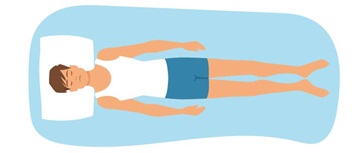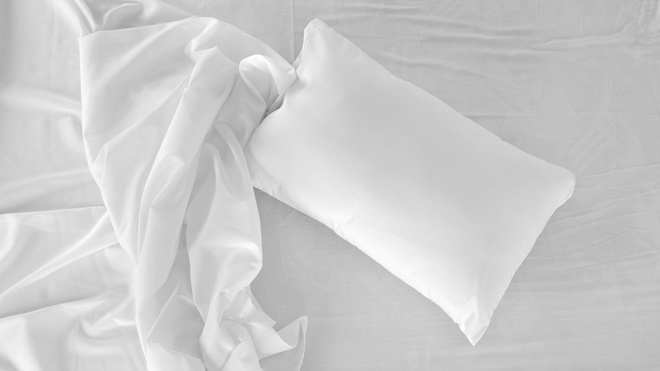Everyone's got their favourite sleeping position: from the back snorers to the tummy snoozers, and every angle in between.
Because some of these positions aren't necessarily great for your posture, it's important to choose the right pillow to support you.
Quality sleep is vital for good health, and a good pillow is vital for quality sleep.
On this page:
- Best pillow for your sleeping style
- Caring for your pillow
- Pillow use-by dates
- Will your pillowcase fit?
- Pillow filling: synthetic vs natural
Best pillow for your sleeping style

You lie flat on your stomach
A soft, flat pillow is best for stomach sleepers, because it gives support without raising the head and neck too far. Synthetic, wool, feathers and down are good options for keeping it low.
You like to curl up on your side
A firm to extra-firm pillow is best for side sleepers, because it ensures your spine is supported properly at a consistent height. Latex and foam are the likely contenders if you love to sleep on your side.
You collapse flat on your back
A medium to firm pillow is best for supporting your head and neck while you sleep. Consider a pillow made from foam.
You like to mix it up
If you sleep in a number of positions, a soft to medium pillow is the best option for you. It might have softer and firmer sections, or one that's lower in the centre (for back sleeping) and higher on the sides (for side sleeping). Pillows made of multiple materials fit this bill.
Caring for your pillow
Before using it
Consider buying a pillow protector – they're quite inexpensive and available in most home and bedding shops. The pillow protector can be easily washed as well. Often pillow slips and/or protectors will stain yellow from a mixture of moisture and oils from your skin. Maintaining your pillow helps to keep your pillow fresh and clean, away from moisture and oils, and will also keep it from staining.
Daily
Give your pillow a good shake and fluff it up. This will help kill any dust mites and keep it fresher and cleaner.
Weekly
Some pillows can be put through a gentle washing machine cycle to keep them really clean, particularly polyester and latex pillows. Check the labels on your pillows, and if they're suitable, pop them in the wash.
Every six months
Test your pillows with our simple four-step method to ensure your pillows are still in good condition.
- Put your pillow on a flat surface and fold it over in half.
- Pop a sports shoe on top.
- If the shoe flies off as your pillow bounces back into its original shape, your pillow is in top form.
- If the shoe stays there, or the pillow doesn't spring back into shape, it's probably time to buy a new one.
Pillow use-by dates
Some pillows are labelled with a use-by date – a useful reminder to check the pillow is still OK.
We explain how often you should replace your pillow, plus other household items like toothbrushes and smoke alarms, in our article use-by dates for household goods.
Why do people replace their pillows?
According to feedback from CHOICE members, most people only have a few reasons for replacing their pillows.
- Just needed replacing (this was accompanied with feedback on staining, or losing shape, volume or firmness).
- Was getting a sore neck/back pain and thought a new pillow would help.
- Pillow had reached its 'use-by' date.
- Saw pillows on sale.
- A professional recommended a particular pillow.
We are fairly skeptical of use-by dates. We were unable to find any scientific evidence to say why a use by date should be applied, and neither Tontine, nor any other source we could find had any evidence as to why there should be a use by date.
Will your pillowcase fit?
Something not many people consider is that the size of their new pillow may not fit their existing pillowcases. You might have a few faves that you use consistently, so make sure you take these into the store, or at least their dimensions, when shopping for a new pillow. It would be annoying to have to spend more on pillowcases because your new pillows don't fit.
When we bought pillows for this test, most claimed dimensions vary only marginally (by about 1–2cm), but there are a few that varied up to 8cm. If your pillowcase is already a tight fit, it's best to bring it into the shop to make sure.
If the pillow is vacuum-packed, ask to see one that's already open. A bricks-and-mortar store will usually have some samples that are already fully expanded from the vacuum packaging. If you try your pillowcase on the sample pillow, give it a wash when you get home.
Pillow filling: synthetic vs natural
Filling and firmness are key factors for a good night's sleep. Here are the most common types.
Foam pillows
Foam keeps its shape for years and is hypoallergenic, so it's a great option if you suffer from allergies or asthma. Memory foam pillows, made from NASA-designed visco-elastic polyurethane, relieve pressure on sensitive areas by moulding to your head, neck and shoulders, but this means they may not be the best choice for restless sleepers because they make it difficult to toss and turn when they're hugging your body.
Lifespan: 5–10+ years.
Latex pillows
Latex is a renewable and biodegradable product made from the sap of a rubber tree. Latex pillows are durable, lasting for years before needing to be replaced, and they have the added benefit of being hypoallergenic. Latex comes in a variety of shapes, profiles and densities.
Lifespan: 5–10+ years.
Feather and down pillows
These pillows are usually made from a combination of the two materials. A higher percentage of down means a softer pillow that will last longer and be moulded and fluffed into your preferred shape, but the more down, the more expensive the pillow. On the downside, they can be a potential allergen.
Lifespan: 5–10+ years.
Polyester pillows
A good-quality polyester pillow is comfortable and supportive, but they tend to form lumps quickly so you'll need to replace them more often than some other types. They flatten easily into a low shape so they're a good choice for tummy sleepers.
Lifespan: Between 6 months and 2 years.
Cotton and wool pillows
These are soft and can be added on top of a firm pillow if you need more support. Both fibre types are breathable, which minimises the risk of oil or sweat stains, and cotton is hypoallergenic.
Lifespan: 3–5 years.
We're on your side
For more than 60 years, we've been making a difference for Australian consumers. In that time, we've never taken ads or sponsorship.
Instead we're funded by members who value expert reviews and independent product testing.
With no self-interest behind our advice, you don't just buy smarter, you get the answers that you need.
You know without hesitation what's safe for you and your family.
And you'll never be alone when something goes wrong or a business treats you unfairly.
Learn more about CHOICE membership today
Stock images: Getty, unless otherwise stated.




